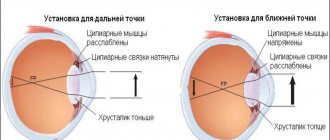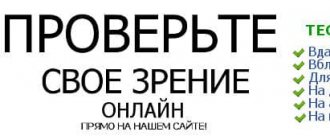It is believed that if a person has excellent vision, his eye shape will be perfectly round. The image that passes through the pupil and lens is normally focused on the macula or macula. However, if for certain reasons the eye muscles spasm, its shape becomes elongated. Then the light rays will focus not on the retina, but in front of it, as a result of which the image becomes unclear.
One of the popular methods of treating and preventing vision pathologies is special gymnastics. Exercises to train the eye muscles in combination with other methods will help achieve good results.
Share
Tweet
Share
Cool
Send
Exercise 1 - blind man's buff
Charging is suitable for cleansing the eyes if a foreign body has entered. It also relaxes the eyes and improves tissue nutrition.
Performance:
- take a comfortable position, lean back in the chair;
- close your eyelids and close your eyes tightly;
- open eyes.
Repeat the exercise 6 times. Gradually increase the number of repetitions to 20. Performed 2 times a day.
Blind man's buff relieves excess tension and eliminates the bad habit of straining your eyes when looking at any objects. Helps get rid of the habit of squinting.
Top 10 eye exercises
There are simple eye exercises that help everyone who faces increased visual stress. It allows you to relax, get rid of dry eyes, and also stimulate blood circulation. Check out a few simple exercises that you can do even at your workplace.
Exercises can be done even at the workplace
Exercises
- Just blink for about two minutes. It is important to do this quickly, but without straining the eye muscles. Exercise helps moisturize the surface of the eyes and also stimulates blood circulation.
- Drive with your eyes open, repeating the silhouette of the number eight. Repeat these movements 5-7 times. Exercise is good for the eye muscles.
- “Drawing” from the previous exercise can be complicated. Move your eyes smoothly, as if you were drawing various geometric shapes in the air, vertical and horizontal arcs, the letter S, arrows directed in different directions.
- Select several objects that surround you - a closet, a door handle, a vase of flowers, and so on. Take a look at their outlines. Repeat the exercise 5-8 times.
- Close your eyes for 3-5 seconds, then open your eyes wide. Perform the exercise 7-8 times to relax the eye muscles and activate blood circulation.
- Make circular movements with your eyes. First 10 times clockwise, then another 10 times in the opposite direction. Once completed, close your eyes and rest for a minute.
- Gently massage your closed eyelids with your fingertips for a minute. This will relieve eye strain, which is especially important for those who spend a lot of time looking at a computer screen.
- Make some kind of mark on the window glass, for example, draw it with a marker, stick a piece of paper, or use plasticine. First, look at the mark, and then look into the distance, to some object that is at a great distance from you - a building, a tree, a lamppost. Repeat 10 times.
- Extend your hand. Bring your finger closer to your face, constantly looking at its tip until it seems to you that it is double.
- Close your eyelids tightly. Cover your eyes with your palms. Sit like this for about a minute, then remove your palms from your face and open your eyes. Repeat everything 3-5 times. This will give your eyes a rest.
Exercise 5 - Pendulum
Helps develop the habit of moving eyes. The pendulum is the simplest and most effective method for improving vision in any form of strabismus.
This is done as follows:
- close your eyes several times to moisten the mucous membranes;
- select an object;
- fix your gaze on it;
- move your eyes along the line left and right and in the opposite direction.
Having lost focus, blink several times and repeat the exercise. Train your eyes in this way at every opportunity. Permission is allowed an unlimited number of times per day.
For those who wear lenses
If you wear glasses, they should be removed before performing exercises. What about those who wear contact lenses? Take them off a few times and then put them back on throughout the day to exercise your eyes? But this is inconvenient.
There are exercises that you can do without even removing your lenses. However, if such eye gymnastics causes you discomfort, you should abandon it and consult an ophthalmologist to select a suitable complex.
Please note: after each exercise done, you need to blink several times.
Exercise No. 1.
Take a pencil. Extend your hand, and then slowly bring the pencil closer to the bridge of your nose - while concentrating your gaze on its tip. Repeat the exercise 10 times.
Exercise No. 2.
Take a comfortable position and relax. Smoothly, slowly, move your eyes so that your gaze describes a circle - first clockwise, and then in the opposite direction. Do the exercise 5 times.
Exercise No. 3.
You will need a dot on the window - you can draw it with a marker or make it out of plasticine. Look at it for 10 seconds, and then move your gaze to a pre-selected object located in the distance: it could be a bush or tree, a house or a lamppost. Look at the object for 10-15 seconds, then move your gaze back to the point on the window glass. Repeat the exercise 5-10 times.
People with astigmatism who wear lenses may have problems during exercise. This is because the toric lenses used to correct this defect must remain in place. If you do the recommended exercises and feel that they are moving, then they will still have to be removed.
Useful video
Evgeniy Slobodsky about the technique of relaxing tired eyes, which can restore vision in case of diseases of the organ (farsightedness, myopia, overexertion, cataracts and others). It is based on vigorous squeezing and unsqueezing of the eyes.
Author's rating
Author of the article
Alexandrova O.M.
Articles written
2031
about the author
Was the article helpful?
Rate the material on a five-point scale!
( 4 ratings, average: 3.75 out of 5)
If you have any questions or want to share your opinion or experience, write a comment below.
Gymnastics for convergent strabismus
For converging strabismus, when the pupils are located closer to the bridge of the nose, an effective exercise is performed using a cardboard mask. It resembles a carnival. It's very easy to make it yourself. To do this you will need a thick sheet of cardboard. You need to cut small holes in it. The diameter of each of them should be 10 mm, no more. The holes should be located in the eye area. You should wear a mask for any visual work: watching TV or reading. Exercises for strabismus will help train the eyeball and direct your gaze in the right direction. In order to make gymnastics more effective, ophthalmologists advise doing certain exercises. You can place an object in front of your eyes. The affected eye, the pupil of which has not changed its position, must be closed and the object moved towards it. At this time, it is important to follow your gaze. Eye exercises for strabismus are similar to those performed for other visual disorders. The figure eight is considered a good exercise. You need to perform movements with your eyeballs that will resemble this number in their shape.
Gymnastics for strabismus
Performing special exercises for strabismus is one of the most effective ways to combat this visual disorder. The consequence of strabismus, especially in children, is often a rapid decrease in vision. The operation is possible only if heterotropia occurs due to a disorder in the structure of the eye muscles. In other cases, ophthalmologists prescribe conservative treatment. The most effective way is to perform special exercises for strabismus. Typically, heterotropia develops due to the fact that the extraocular muscles do not work correctly. This may be due to their weakness or, conversely, a state of regular tension. It is necessary to train the muscles of the eye. This will help:
- increase vigilance;
- reduce eye muscle tension;
- tone the visual organs;
- restore binocular vision;
- eliminate discomfort.
Gymnastics for strabismus allows you to normalize the functioning of the muscle structures of the eyeball. They take the correct position in relation to each other and the common axis. To eliminate strabismus in children and adults, exercises must be performed according to different rules. Correction of convergent and divergent forms of strabismus is carried out using separate complexes that are designed specifically to correct specific types of heterotropia.
Complex of corrective gymnastics for the eyes
Methods of corrective gymnastics for the eyes
Introduction
In the modern pace of life, it is extremely important to remain a healthy person in all respects. Not the last in the series of necessary “characteristics” is normal vision. Unfortunately, a sedentary lifestyle, long-term work with computer technology, inactivity, constant stay indoors, poor diet and nervous disorders sometimes lead to very serious strain on the eyes, which can subsequently lead to severe complications - myopia, amblyopia, presbyopia, astigmatism, detachment of the retina, etc. To maintain a decent level of vision, relaxation and vision correction techniques are used, the number of which is quite large; This essay is devoted to consideration of the latter.
Vision problems
The human eye, although a fairly simple device from the point of view of optics, is quite complex from the point of view of biology and medicine. Light, penetrating the cornea and pupil, passes through the lens, then through the vitreous body, to ultimately reach the retina, interact with the cells on it and cause nerve impulses to the brain. Having processed the incoming signals, it gives our imagination an idea of the shape and nature of the light field, i.e., in simple terms, a picture. According to the mechanism of vision, several vision problems can be identified that arise as a result of physiological, biochemical or other disorders.
The so-called geometric vision problems are associated with changes in the geometry of the eye, i.e. its forms. Depending on the nature of the changes that have occurred to the eyeball, myopia is distinguished - when the latter is flattened, presbyopia - when its length is reduced, astigmatism - when the apple is compressed in such a way that the eye becomes like a suitcase, and others. Such distortions most often arise due to uneven or poor training of the eye muscles and can be corrected in several ways: surgically, when special restraining brackets are put on the eye, protecting it from changing size, laser, when in some way the retina of the eye is affected, as a result which improves its perception properties, optically - with the help of widely used glasses or contact lenses, when the flow of light entering the eye changes, and finally, gymnastically, when the very cause of the disorder is eliminated - insufficient training of the eye muscles. Methods of gymnastic correction are discussed below.
William Bates Method
At the beginning of the last century, American ophthalmologist William Bates conducted a study on visual disorders. The result of his work was the conclusion about the small role of the lens in the formation of the light beam arriving at the retina, and the dominant role of the periocular muscles. In his book, Improving Vision Without Glasses, Bates gave many tips for those who want to see better. The enormous popularity and number of editions the book has gone through testify to its fairness and applicability. Even now, seven decades later, the Bates method is widely used to correct visual impairments.
The method is based on the principle of relaxing the eye muscles during and after visual stress. Bates advises, in addition to regular rests and changing the visual object (once an hour for 10-15 minutes), to do so-called palming - covering the eyes with the palms to ensure the blackness of the light field, in other words, its complete absence. The term comes from the English word palm - palm and perfectly illustrates the principle of its action. In addition to the absence of light, the palms also provide thermal stimulation to the eyeballs, bring relaxation and, according to Eastern religions, restore energetic balance in the eyes and associated organs. Palming is recommended to be done every half hour or forty minutes for five to seven minutes.
In addition to palming, another remedy for restoring vision is relaxation. Bates teaches you to be able to relax your eyes by imagining a black field, as in palming, every time you perform any visual work. Feedback from his readers and students suggests that if this rule is followed, the eyes are constantly in a relaxed state, do not strain, therefore, there is no additional unnecessary tension in the periocular muscles, which leads to a long-term preservation of the effect of improved vision observed after palming.
Bates also offers a set of exercises to directly strengthen the eye muscles that are easy enough to remember and perform. Its undoubted advantage is that the complex can be performed almost anywhere at any time, that is, to strengthen your vision, you can use your free minutes at work, in transport, in line at the store. The complex consists of exercises performed with the eyeball and eyelids. To fully work out all the muscles, it is recommended to do it three times in a row with an enhanced second approach several times a day.
Complex of corrective gymnastics for the eyes
Blinking rapidly for 10 seconds.
Increased compression and release of the eyelids, 6-12 times.
Blink frequently for another 10 seconds to relieve tension.
With eyes closed, move the eyeball left and right, 10-20 times.
With eyes closed, move the eyeball up and down, 10-20 times
With eyes closed, move the eyeball “in a square”: right-up – right-down – left-down – left-up, 6-12 times in each direction.
With eyes closed, move the eyeball in a circle, 6-12 times in each direction.
With eyes closed, diagonal movements of the eyeball, from one corner of the “square” to the opposite, 6-12 times.
Regular performance of these exercises together with palming and relaxation can give good results after just a month of training. Among the reviews of Bates's book were the results of vision improvement doubling in six months.
Based on the training of the eye muscles, techniques have been created that use optics to improve vision. We are not talking about glasses prescribed for distance, work or constant wearing, but about special training with a large number of glasses. The methods of Volkov, Avetisov and Dashevsky are widely used in children's health institutions. The essence of the methods is that a person, when performing visual work, uses glasses with different optical powers, remaining in one for no more than 2-4 minutes. At the same time, the eye muscles are constantly tensed and strengthened. To maintain the effect, blueberry, calcium and zinc preparations are often prescribed.
Palming
This technique was developed by ophthalmologist Dr. Bates. A person needs to sit more comfortably and rub his palms until warm.
Place your hands with your palms up in front of you, place your elbows on the table or back of a chair and secure them. The fingers should be joined together. Place one hand on top of the other in the form of a house roof and in this form bring it to your face, covering your eyes with your palms, fingers should intersect on your forehead. The nose should be open and located between closed palms.
In this form, do the following exercise:
- close your eyes, relax and sit in silence for a couple of minutes;
- then open your eyes - your hands should be positioned so that even with your eyes open there should be darkness behind your palms;
- imagine darkness, a black velvet curtain and warmth, think about good, pleasant and good things;
- The duration of the exercise is 3-5 minutes.
To exit the exercise, without removing your palms, close your eyes and relax for a couple of minutes, then nod your head, remove your palms and blink.
Repeat palming if fatigue or discomfort occurs. At first, at the beginning of the exercise, color images may flash before your eyes - rays of the sun, light, TV.











